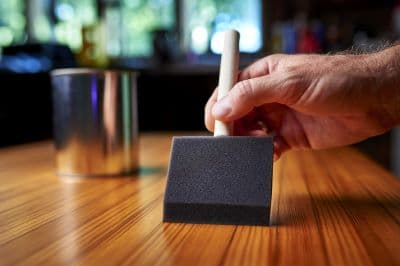
Adding a layer or two of polyurethane over a painted project can protect the surface. However, you need to wait for the paint to dry before applying the polyurethane, or the two can meddle and turn into a mess. When done correctly, polyurethane will add a beautiful shine and a layer of protection to a painted surface.
First, though, you need to wait between 24 to 72 hours for the paint to not just dry but cure before applying the polyurethane. Several factors will affect the drying time of paint and polyurethane too. Let’s go over all the different aspects to help ensure a well-finished project ready to make your home beautiful.
Why You Should Wait for Paint to Dry
The main reason you need to wait for the paint to dry before adding polyurethane or any other topcoat is to prevent the two products from meddling, which can cause a rough and unclean surface. When done incorrectly, the paint and polyurethane will be more susceptible to damage and wear too reducing the usefulness of a project. Polyurethane can protect from dirt, water, fungus, and fading as a barrier, but only when applied correctly.
Difference Between Drying and Curing Paint
Paint will dry first and then cure, which is hardened to a finished product. Drying means the solvents have evaporated, while curing means it’s ready to use and fully finished. Do not apply polyurethane until the paint has had time to cure fully. To find out if the paint is dry, simply touch it to see if it is sticky or comes off on your fingers. If you want to know if the paint is cured, use a fingernail on the paint. A visible mark means the paint has not finished hardening yet.
Factors Affecting Drying Time
Many factors can affect the drying time of paint. First, the type of paint can affect the drying time. Latex or water-based paint will take between four hours to a full day to dry, depending on the thickness of the layers and the environment. Curing will take between three weeks to a month!
Oil-based paint takes between six to eight hours to dry and three days to a week to fully cure. Chalk and milk paint takes about an hour to dry and a month to cure. While you can use polyurethane over dry paint, it’s best to allow the product to harden fully before applying the protective coating.
Other factors that can affect drying time include the type of wood, the environment, and ventilation. Chemically treated wood may not dry or cure properly and cause issues, while not treated wood can dry differently for soft or hardwoods. Furthermore, different levels of humidity and temperature can affect drying time too. Ensure your work area stays properly ventilated to help paint dry quicker.
Drying Time for Polyurethane
Polyurethane comes in two types – water-based or oil-based. Both offer different benefits and issues.
Oil-based polyurethane turns projects slightly yellow when finished but forms a hard thick protective coat. Drying oil-based poly takes longer, about 24 hours, especially with thick layers. However, it does not cure for about a month before you can fully put the product to use. Also, oil-based poly has VOCs and can be quite noxious, so plan for protective gear.
Water-based polyurethane drys clear and is much more environmentally friendly as it does not contain VOCs. Drying times for water-based poly are about six hours, depending on the thickness of the layers. Curing will still take a month.
Applying Polyurethane Over Paint
As with all projects, applying poly over paint will take several steps. Remember first to pick between water or oil-based polyurethane and remember water-based dries clear while oil-based adds a yellow tint. Polyurethane can go over and fully dry paint.
Step 1: Ensure the painted surface is dry and clean. Remove any stains or grime as polyurethane will seal in mess too. Use trisodium phosphate mixed with water on a sponge to clean painted surfaces easily.
Step 2: Use sandpaper to scuff the surface and prepare it to take the polyurethane. Try 120-grit sandpaper to prevent deep scratches but still allow for a level working area. You can use a sander or work by hand if you prefer, but remember to clean the area again to remove the dust created from sanding.
Step 3: Apply the first coat with a brush or sprayer, depending on the size of the surface. Do not use a roller to apply polyurethane as it can cause bubbles in the surface. Keep the layer thin to allow it to dry properly. Once it’s dry, scuff again with sandpaper to level the surface. Always wait for the surface to dry before sanding and moving to the next step.
Step 4: Apply the second coat the same way as the first. As the surface is already painted, you should not need a third coat. Allow it to dry completely. You do not need to sand this layer, but you can apply wax.
How to Reduce Drying Time
While you may be tempted to reduce the drying or even the curing time of a piece, it’s best to let the process take its natural course. The first step requires evaporation of liquids and the second step allows the product to harden. You can help the natural course a little by changing the environment by controlling the temperature to 50 to 77 degrees, which is favorable for polyurethane. Turn on the air conditioner in higher heats or a heater for colder temperatures. Finally, always allow for proper ventilation as airflow is necessary for a project to dry correctly.
Final Thoughts
Paint will take between 1 to 3 days to fully dry before you can apply polyurethane. You may want to wait a full month for the paint to cure before applying polyurethane, but this is unnecessary. Make sure to control the environment and follow the appropriate steps to ensure a nice finish on your project.